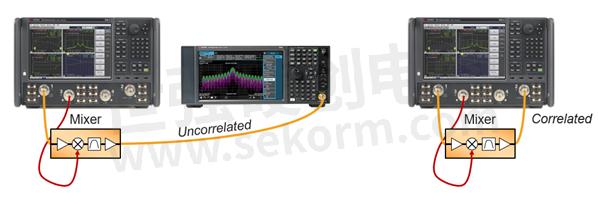How to Make Phase Noise Measurements on a Frequency Converter?

eneration of radio-frequency (RF) and microwave signals is essential when testing high-performance systems in critical industries like communications or aerospace and defense. In many cutting-edge radar and communications systems, phase noise limits system efficiency. Take radar systems as an example, phase noise degrades the ability to process Doppler information rendering a target undetectable. This can affect the prediction of severe weather, the determination of flight conditions and can even impact a country's defense system. Let's delve a little deeper in the basics of phase noise and then take a closer look at how to make phase noise measurements on a frequency converter.

Phase Noise 101
Phase noise is defined as a ratio of the power density at an offset frequency from the carrier to the total power of the carrier signal. Measuring phase noise can be challenging and time-consuming as it depends on different factors: internal architecture, type of oscillator, internal and external frequency references, and the effects of built-in capabilities. Testing your setup by integrating clean signal generation and high-performance spectrum analysis at the same time creates even more of a challenge.
There are three methods to measure phase noise, from basic to intermediate complexity: direct spectrum, carrier removal, and cross-correlation. The decision of which one is the most appropriate depends on the nature and complexity of your device.
Phase Noise Measurement Use Case
Now that you understand a little bit more about phase noise, let’s take a closer look at a specific use case that is the foundation of modern radar and communication systems: measuring the phase noise of a frequency converter with an internal local oscillator (LO).
Testing frequency converters involves capturing many parameters, including gain, phase, delay, intermodulation distortion, and noise figure. So, when you have your test results, you need to know the source of the output signal phase noise.
You can make these measurements using the phase noise measurement application on Keysight's PNA-X network analyzer. The application eliminates the need for a separate external high-performance signal analyzer or dedicated phase noise measurement system. Internal direct digital synthesis (DDS) sources simplify the measurement setups even more, while improving the phase noise by 30 dB, with 30 dB lower dynamic range in sub-terahertz bands. It also allows you to measure the phase noise of RF signal sources and two-port active devices such as embedded-LO frequency converters.
The figure shows two phase noise measurement setups. The phase noise measurement setup on the left uses the PNA-X as LO and makes an uncorrelated measurement on an external signal analyzer. The one on the right, however, uses the PNA-X as both a source and analyzer. This allows correlated phase noise to be removed to a first order, improving measurement sensitivity.

Figure. Source and receiver uncorrelated vs. correlated
The uncorrelated setup uses the following:
PNA-X with DDS source as LO
PNA-X DDS source as input
PXA signal analyzer, uncorrelated with the PNA-X, makes the measurements
In contrast, the correlated setup uses the following:
PNA-X with DDS source as LO
PNA-X with DDS source as input
PNA-X makes the measurements
Here, since the PNA-X provides the input signal as well as making the measurements, we are able to remove phase noise to the first order. The result is close-in phase noise goes from about -91 dBm (uncorrelated) to -108 dBm. Farther out, it goes from about -122 dBm (uncorrelated) to -128 dBm. Phase noise improves by ~17 dBm close-in and ~6 dBm farther out.
In this setup, the phase noise improved using the new DDS sources of the PNA-X. The flexibility and performance of the PNA-X simplifies the test setup by integrating clean signal generation, while improving the accuracy of phase noise measurement.
The Bottom Line
Test time and measurement precision are foundational considerations in the development of mixers and frequency converters for cutting-edge radar and communication systems. Keysight PNA-X network analyzers will help you improve your phase noise measurements. They also allow you to simplify the measurement setup to measure gain, delay, error vector magnitude, noise power ratio, gain compression, and other key parameters, all at the same test station.
- +1 Like
- Add to Favorites
Recommend
- Keysight Technologies Acquires Quantum Benchmar, Augmenting Keysight‘s Quantum Portfolio
- Keysight First to Gain OmniAir Qualified Test Equipment Status, Accelerating C-V2X Device Certification
- Keysight First to Gain GCF Approval of Cases for Validating 5G New Radio mmWave Devices in Standalone Mode
- Keysight Massively Parallel Board Test System Selected by LACROIX in Automotive Printed Circuit Board Manufacturing
- Keysight, TIM and JMA Wireless Join Forces to Showcase O-RAN Technology at Mobile World Congress 2021
- Keysight, Xilinx and Cisco Showcase Solutions that Support Smooth Migration from 4G LTE Networks to 5G Open RAN
- Keysight Unveils the First Media Access Control Security Test Solution for High Speed Ethernet
- Keysight, MediaTek Join Forces to Establish 5G Connectivity Based on 3GPP Release 16 Specifications
This document is provided by Sekorm Platform for VIP exclusive service. The copyright is owned by Sekorm. Without authorization, any medias, websites or individual are not allowed to reprint. When authorizing the reprint, the link of www.sekorm.com must be indicated.
























































































































































































































































































































































































































































































































































































































































































































































































































































































